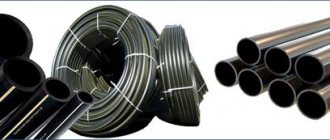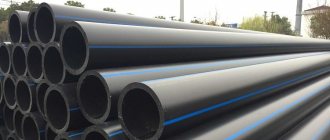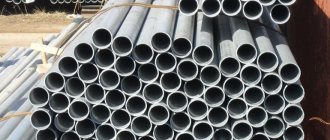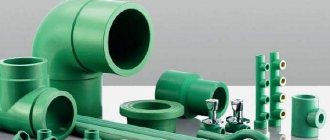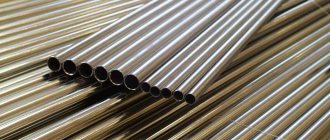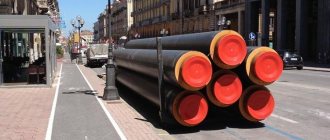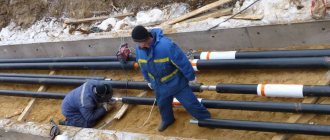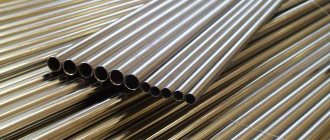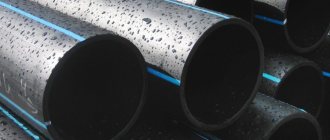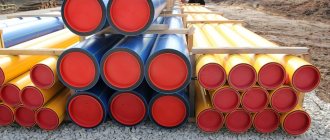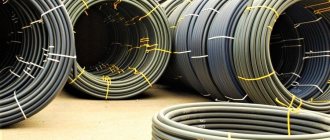HDPE plastic pipes for cables have significantly simplified and reduced the cost of communications. Plastic polyethylene pipes have a number of advantages over steel pipes. Technical HDPE pipes are much less susceptible to corrosion as a result of temperature changes. Polyethylene pipes, unlike steel ones, do not rust or burst when water freezes. These qualities ensure the operation of PE pipes for decades, without the need for their constant maintenance, repair and replacement. Our company is engaged in the production and sale of high quality technical HDPE pipes. The main part of our company's products are HDPE polyethylene pipes with a diameter of 20 mm to 160 mm.
HDPE technical pipe.
In the production of our pipes, prepared batches of recycled low-density polyethylene (HDPE) are used. The scope of application of the product is purely technical, mainly as a protective sheath for cables during electrical installation work. Technical HDPE pipes are manufactured mainly in dark, uniform colors - from gray to black. Depending on the needs of consumers, several options for finished products are available: with different wall thicknesses and with different diameters of HDPE pipes from 20 to 160 mm. It should be noted that products in coils are available for certain diameters (20, 25, 32, 40, 50, 63, 75 mm). HDPE pipes can be ordered in lengths with a diameter of 75, 90, 110 and 160 mm.
Technical characteristics of polyethylene products
The installation of a water supply system begins with its design. And to create such a project, you need to understand the technical characteristics of the pipes. They may vary for products of different diameters. But the melting point for all products will be the same - +120...+135°C.
All types of pipes can withstand frosts down to -70°C. The density of most products is 948-960 kg/cubic. m, and the specific heat capacity is in the range of 2300-2700 J/(kg*K). In this case, the characteristics of the required model can be found in the accompanying documentation.
Polyethylene pipes from the manufacturer.
Since our company independently produces HDPE polyethylene pipes, we are able to offer very attractive prices for the entire range of products. PE plastic pipes are sold both retail and wholesale. For regular customers and large wholesalers, we provide even lower prices, individual terms of cooperation and delivery. Selling polyethylene pipes from the manufacturer allows you to significantly save on cost. As a result, you get a competitive advantage in the construction of communications, be it laying electrical wiring or creating a sewer system.
At your request, polyethylene sewer pipes for small diameter cables are supplied in coils of various lengths. Large diameter polyethylene pipes 90-160 mm are sold in lengths up to 12 meters. Payment is made in cash or by bank transfer. In case of long-term cooperation or production of a large batch, it is possible to conclude a contract and be accompanied by the necessary package of documents. For your convenience, pipes are delivered throughout Moscow, the region and to the regions of Russia. The supply of HDPE polyethylene pipes to the regions is carried out only through trusted transport companies.
You can contact us by contact numbers or send an email with a question or commercial offer. Our specialists will advise you on the availability of goods in the warehouse and help you choose the desired diameter and length of pipes. If there are currently discounts or promotions, you will also find out about this.
Types of PE and its production technologies
There are two methods for producing pipe high-density polyethylene (HDPE) - suspension and gas-phase.
Using suspension technology, polymerization is carried out in an organic solvent (gasoline, hexane) with the addition of Ziegler-Natta catalysts (titanium chloride, aluminum alkyds). Ethylene is fed from below through a bubbler into a cylindrical stainless steel reactor, where it is dissolved in gasoline and converted into a copolymer.
In the gas-phase method, the compressor simultaneously pumps ethylene or its comonomer along with hydrogen, butylene and propylene into the working chamber from below. A catalyst mixed with nitrogen is also fed into the reactor. The resulting polyethylene from the bottom of the tank is sent to the separator, then it is purged, stabilized and granulated.
Rice. 3 HDPE grades according to GOST 16338-85
In the production of PE, the most common suspension method uses the following technologies:
- Polymerization of ethylene raw materials in an initiator medium (oxygen or peroxide) at elevated pressure of the order of 1500 - 3500 kgf/cm2 and temperatures of 200 - 300 °C. The resulting low-density high-pressure PE (LDPE) due to the presence of side hydrocarbon chains in the crystal lattice has a relatively low degree of crystallinity of 50 - 60%.
- Polymerization of ethylene at low pressure of about 1 - 5 kgf/cm2 and temperature 70 - 80 °C in a catalytic solution. As a result, long and less branched macromolecules with a degree of crystallinity of 75 - 85% are obtained. The resulting material is called high-density PE (HDPE) and low-pressure PE (HDPE, HDPE).
- Polymerization of ethylene mass under a pressure of 30 - 40 kgf/cm2 and a temperature of 100 - 120 ° C in a catalytic solution. The resulting component has a degree of crystallinity of 80 - 90% and is called medium-pressure high-density polyethylene PESD (PSD).
If we consider the technology for the production of HDPE, it becomes obvious that this production of PE, in comparison with other technical processes, is the most cost-effective and provides high characteristics of the produced thermoplastic. This greatly influenced its spread and leading position.
Related article:
Properties of polyethylene used for the manufacture of pipes and fittings. This article describes in detail the main properties of polyethylene such as: density, resistance to temperature and weather influences, tensile strength, linear expansion, and so on...
Rice. 4 Multi-layer and single-layer PE corrugated pipes
HDPE pipe plant.
Our HDPE pipe plant offers its products to buyers from all regions of Russia. The production process is based on an integrated approach, which is expressed in a clear, structural division of technological operations at each individual stage of processing secondary raw materials and pipe production. The sequential implementation of production stages allows us to systematize quality control and compliance with the required standards in the manufacture of technical products.
In order to improve quality indicators, the main production lines of the plant have undergone complete modernization. Modern equipment has significantly reduced the loss of energy resources and waste of consumables, which has a positive impact not only on the quality indicators of products, but also served as a factor in significantly reducing the final cost of products.
Production of HDPE pipes in any volume.
We have our own production of HDPE polyethylene pipes near Moscow. This allows you to significantly save on delivery, which in turn is reflected in the final price of the products. Pipes are made only from high-quality raw materials using the latest equipment. The reliability of plastic pipes has been verified by load tests and real operating conditions. And the high quality of our products is confirmed by relevant certificates. Our company has a number of advantages:
Our production of HDPE pipes allows us to produce as many meters of product as the customer needs, which speeds up the construction of communications. The proximity to Moscow makes delivery possible in the shortest possible time. This is especially true for urgent repairs and replacement of technical pipes. The range includes HDPE pipes of various diameters, intended for electrical installation work and sewerage. We also produce polyethylene pipes with non-standard wall thickness to order.
How is installation carried out?
No special preparation is required to connect PE products and compression couplings. Even a beginner can do this kind of work. First, polyethylene pipes are cut to the required size. They can be easily sawed with a hacksaw or a special pipe cutter.
The edges at the cut site are well cleaned. A small chamfer is made along the entire diameter.
The coupling parts are put on the cylindrical elements, observing a certain sequence. Their ends are inserted into the fitting body. The connection is securely tightened.
Below is an illustration that shows in an accessible form how HDPE water pipes should be connected.
Plastic pipes for cable.
One of the most popular areas of application for low-pressure polyethylene pipes is the installation of hidden and underground cable power lines. The main task that shell pipes successfully cope with is protecting the channel from possible mechanical damage or from contact with moisture, dirt, soil and other external objects. The plastic pipe for the cable is uniform over the entire cross-sectional plane and has excellent resistance to the formation of chips and cracks. In most wear resistance parameters, plastic HDPE pipes are superior to similar PVC products.
Other distinctive features of HDPE pipes include their insulation resistance, which is important in the process of laying and operating electrical networks. In addition, sewer plastic pipes for cables have a long service life of at least 50 years and reliably withstand temperature fluctuations. Also, HDPE plastic pipes simplify the process of installation and replacement of electrical cables. Thanks to the wide range of available sizes, you can choose the required pipe volume, which will allow you to fit all the cables into one trunk.
PE pipe from the factory. We work without intermediaries.
Our own production of technical PE pipes opens up wider horizons for the successful sale of products. The most tangible advantage that the absence of intermediaries promises is the lowest possible price (not only wholesale, but also retail). In addition, the established production of plastic pipes for cables allows us to work directly with the consumer, which is especially important when ordering products of a non-standard configuration.
Direct deliveries of PE pipes from the factory increase the degree of safety of products and reduce the costs of additional logistics operations: transportation, loading and unloading, warehousing, storage. Products from the manufacturer are a guarantee of quality, safety and reasonable price. In addition, you can always order a batch of pipe with unique parameters, which is not always available when working with intermediaries.
The experience gained as a result of the stable activities of our enterprise allows us to successfully form a base of permanent suppliers of recyclable materials who offer proven products. This approach serves as an additional guarantee of creating favorable conditions for obtaining a safe final product.
Black HDPE pipes made from recycled materials.
The determining factor for the use of PE technical pipes is the material that is used as the main one in the production process. Polyethylene can be easily recycled; for this reason, recycled materials are often used as the main source material in the production of HDPE pipes.
The feasibility of using recyclable materials is also dictated by the unique opportunity to find useful uses for already used materials, which are otherwise sent to a landfill. Black HDPE pipes made from recycled materials are ideal for technical purposes, such as laying electrical cables, installing telephone lines, and installing computer networks. Black pipes made of low-density polyethylene are the best option for installing affordable and reliable communication networks.
Pipe connection options
To install HDPE pipes, you need to understand how they can be connected. There are several options:
- Welding using a special apparatus, in which the ends of polyethylene products are heated to the desired temperature and then connected. It is important that the cuts are smooth. Welding connections are considered the best option for installing a water pipeline laid in a layer of soil.
- Using compression fittings. There are many varieties of such elements. These are tees, couplings, flanges and much more. With their help, systems of rather complex configurations are assembled. But this method is not suitable for water pipes that will be laid underground, since the fittings require regular maintenance.
- Electrodiffusion welding, for which thermoresistive fittings are used. A special feature is resistance to high temperatures, and from a design point they are distinguished by the presence of a heating spiral and special sensors. On their surface there are terminals for connecting the welding unit. The prepared ends of the pipes are inserted into these fittings, and then welding is started. The inner spiral of the fitting heats up during the process, the material of this hot element imparts heat to the polyethylene of the pipe, and it melts. This method is suitable for laying a pipeline in the ground.
- Flange connection. This type of joining is most often used when there is a need to switch to another type of pipe.
At the same time, the installation technology is simple. And even if you don’t have the skills, you can install HDPE pipes for the water supply system in your dacha on your own, without involving specialists, which will save money.
Manufacturing and delivery of technical pipes in Moscow, the region and throughout Russia.
We not only have a modern production of technical pipes, but also provide additional opportunities for consumers: delivery, individual orders, discounts. The diameter of the plastic technical pipe can be from 20 mm to 160 mm, making it easy to choose the required size for your project. An integrated approach to the formation of a sales market must necessarily include the stage of product delivery. A separate structural unit of our plant delivers PE technical pipes in Moscow, the region and other regions of Russia.
An important factor for the customer is the prompt delivery of materials for reconstruction, repair and installation of communications. We guarantee fast delivery of the required quantities of goods using specialized transport. When ordering large volumes, HDPE pipes can be delivered in several batches. The arrival of the first part of the order will allow the customer to begin the installation process earlier. Transportation of any batch of technical pipe can be carried out on individual terms, by separate agreement.
Methods of connections when laying HDPE pipelines
When laying a HDPE pipeline, its sections can be connected detachably or permanently. Detachable connections are made using threaded fittings, which make it easy to carry out repair work and replace a damaged pipe. Permanent connections are made using butt welding or electrofusion welding.
In the first case, using a welding machine, the prepared ends of two pipes are melted, carefully aligned, pressed and fixed until completely solidified. Such a seam is comparable in strength to solid material and is used for gas and water pipelines.
The electrofusion method involves welding the ends of two pipes inserted into a coupling with a built-in heater. It does not require much skill from the performer, but is more expensive due to the relatively high cost of the electric coupling. You can optimize costs and use it only in hard-to-reach areas of the highway.
Free-pressure pipes for cable drainage.
Black HDPE pipes can be used to install cable ducts and free-flow drainage systems. The chemical resistance of polyethylene allows them to effectively serve in storm drainage structures, main conduits, local and global networks. Thanks to optimal performance characteristics (minimum weight, elasticity, strength, corrosion resistance, etc.), non-pressure PE pipes are confidently replacing analogues made from steel and asbestos-cement materials.
A long service life is guaranteed if the operating conditions of the pipes are met. For example, the use of polyethylene pipes for the circulation of liquids with pressure levels above 0.4-0.5 MPa is prohibited, and the material is also not suitable for transporting liquids with temperatures exceeding 40 degrees.
Properties, advantages, disadvantages
Polyethylene pipes are used to transport various liquid and gaseous substances. In the literature you can find an abbreviated designation: in the Russian version it is PE, in the international version it is PE or PE-X for cross-linked polyethylene.
They have excellent properties:
- The material is chemically neutral and does not react even with hydrochloric acid. Due to this they are used in production processes.
- In its normal state it does not emit any substances and do not affect the taste of transported liquids. This allows them to be used in the construction of pipelines through which liquids that can be consumed circulate.
- The inner walls of polyethylene pipes are very smooth and no substances are retained on them. Even after many years there will be no deposits on them.
Polyethylene pipes can be of different diameters, with different wall thicknesses - Smooth walls have less resistance to water flow. Less resistance - a less powerful pump is required for pumping, less electricity is consumed.
- Service life under normal operating conditions is about 50 years. But this figure decreases sharply with increasing temperature or pressure.
- Easy to cut, lightweight, easy to install.
- They do not conduct currents and do not corrode.
- Polyethylene pipes with a diameter of up to 160 mm can be connected using special fittings. They are simply installed without any equipment, which is convenient in “field conditions”, for example, in the country. Large diameters are welded with a special apparatus, but they are usually used in industry.
Compression fittings for polyethylene pipes are simply screwed into place - Polyethylene does not conduct sound well. So such a pipeline or heating system is “quiet”.
- The price of a polyethylene pipeline is 30-40% cheaper than a similar steel one.
- An already finished plumbing or heating system is easy to redo. The pipe is cut in the right place, the required fitting is installed, to which another branch or any device can be connected.
An excellent set of properties has led to the fact that polyethylene pipes are becoming increasingly popular. But to avoid surprises, you need to know their shortcomings. There are not very many of them, but they are quite serious.
- Polyethylene burns and releases harmful substances when burned.
- Weak resistance to ultraviolet radiation. When exposed to the sun, the material becomes brittle and brittle. But cross-linked polyethylene pipes are not susceptible to this disease; they have recently become the best sellers.
- Large thermal expansion - it is 10 times greater than that of steel. To neutralize this drawback, a compensator is installed.
- When the liquid in the pipeline freezes, the polyethylene may rupture. Therefore, when using polyethylene pipes to organize water supply for a private house or cottage, it is laid below the freezing depth or insulated on top, and additional heating methods (heating cables) are used.
These are all shortcomings. Now about the varieties. According to the production method, there are three types of polyethylene pipes:
- high pressure;
- low pressure;
- made of cross-linked polyethylene (often red, as in most cases they are used for laying heating and hot water systems).
Cross-linked polyethylene tolerates transportation of hot media
There is a certain paradox hidden in these names. When they talk about high or low pressure polyethylene pipes, they mean the method of their production. But often it is perceived as an area of use. In reality, it's the other way around. Pipes produced at high pressure are less durable. They can only be used for free-flow systems (without pumps). They are made for pressure water supply systems, but the strength is gained due to the thickness of the walls. With normal wall thickness, their area of use is sewerage, drainage systems, storm drains, etc. Here their qualities are optimal.
In pressure pipelines, where there is high pressure, low-pressure polyethylene pipes are used. They are more durable but, at the same time, more fragile and bend much worse. This is also not very good. But they can withstand significant pressure changes without any harm. And it must also be said that both of these types of polyethylene pipes are only suitable for cold water - they cannot withstand hot water and can melt.
Pipes made of cross-linked polyethylene PE-X are used in the installation of water heated floors
But the third type - made of cross-linked polyethylene - is an option with high strength and flexibility. Such products can withstand high pressure (up to 20 atm) and temperatures up to +95°C, that is, PE-X pipes can be used for hot water supply, as well as for heating systems. By the way, this type of polymer is used to make metal-plastic pipes. However, there is one “but” here - this type of material cannot be welded. When installing a pipeline made of cross-linked polyethylene, fittings with gaskets are used. The second type of assembly is adhesive, when the joints of the connected elements are coated with glue.
HDPE polymer pipes. Tested by time.
HDPE polymer pipes are made from low-density polyethylene from reliable suppliers. Our polymer pipes are used in various communication projects throughout Russia. Thanks to the high quality of our products and low prices, many customers become our regular partners.
The use of HDPE materials is not only justified economically, but also practical. Low specific weight allows you to reduce the costs of transportation, installation and subsequent maintenance. Also, technical communication elements have an optimal set of properties and characteristics. Among the advantages of HDPE polymer pipes, the following deserve attention:
- Acceptable price;
- Safety (no harmful substances);
- After the end of their service life, they are suitable for recycling;
- Show optimal resistance to aggressive environments;
- Can be used in temperatures ranging from minus 50 to plus 40 degrees;
- Long effective service life, which, if the manufacturer’s requirements are met, exceeds 50 years;
- Wide scope of application;
- Polyethylene has excellent corrosion resistance;
- The material allows you to successfully use the advantages of flexibility and elasticity of the pipe during installation.
Pipeline laying methods
Installation of HDPE water supply can be carried out in two ways:
- Open (above ground). A common method among summer residents, such a system can be quickly assembled and disassembled for the winter to avoid exposure to low temperatures. It is mounted in the form of a circuit using fittings and branches. The disadvantage is that if handled insufficiently carefully, the lines may be damaged by equipment (for example, a trimmer), so the installation should be carried out on special supports.
- Trench (in the ground). Laying the pipeline is possible by laying collectors in specially prepared trenches. In this case, it is recommended to mark the location of the pipes to avoid damage. If you need to install a stationary underground water supply system, you will additionally need a heating cable - thanks to it, the pipeline will work equally in both summer and winter. It is important to think through the laying scheme in advance.
HDPE pipe diameters from 20 to 160 mm in stock and on order.
Our plant for the production of HDPE technical pipes is ready to provide customers with products with a diameter from 20 to 160 mm. Sales of polyethylene pipes in sections are provided for products with a diameter in the range of 75-160 mm. HDPE pipe diameters 20-75 mm are sold in coils. There is always a wide range of finished products in stock. It is possible to order a specific batch of products, taking into account the individual requirements of the client: quantity, diameter, wall thickness, production time. Regardless of the complexity of the order, the experienced employees of our plant will cope with the task.
We guarantee the consumer exclusively high-quality products made from only proven raw materials from regular suppliers. Our specialists are ready at any time to provide qualified advice on the selection, installation and maintenance of HDPE pipes.
Installation Rules
When installing cylindrical products made of polyethylene, the laying depth must necessarily exceed the corresponding value of soil freezing by about 20 cm. If we take the Moscow region, this value reaches about 1.5 m.
The trench must have a bottom whose width exceeds the diameter of the pipe by 40 cm. If welding work takes place directly in the recess, then it is made quite wide so that the special apparatus can fit freely.
To maintain the integrity of the pipes, the bottom of the trench is well leveled and then filled with solid inclusions. Next, a sand cushion is made, the layer thickness of which is 10-15 cm. When laying pipes trenchless, organizing the base and backfilling is not necessary.
After the installation is completely completed, backfilling must be done. First, a layer of sand is placed, which covers the pipe approximately 15-30 cm above its top point. The trench is then filled with any suitable material, such as stones or construction waste. When laying PE water pipelines under roads, backfilling is done only with sand, compacting its layer each time.
